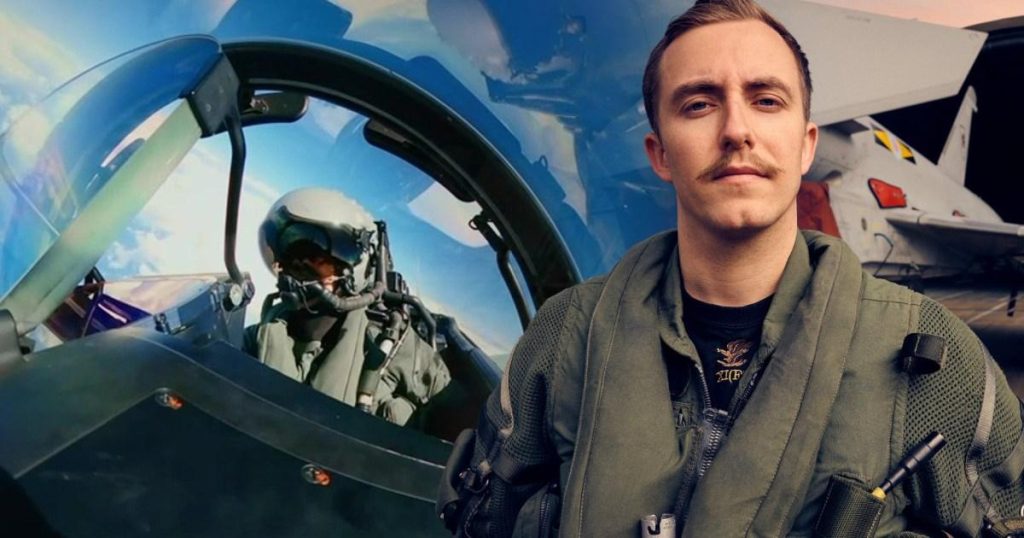The escalating tensions between Russia and the West, particularly in the wake of the Ukraine conflict, have brought the silent aerial battles between their respective air forces into sharper focus. A recent incident, captured on cockpit footage and detailed in a Channel 4 documentary, “Top Guns: Inside the RAF,” illustrates the high-stakes game being played in the skies near Ukraine. Two RAF Typhoon fighter jets, tasked with escorting a Rivet Joint spy plane on an intelligence-gathering mission over the Black Sea, received a chilling warning from Russian forces: “You are approaching the state border of the Russian Federation combat zone. If you don’t leave, you will be destroyed.” This stark warning underscores the precarious nature of these aerial encounters, where a miscalculation or escalation could have devastating consequences. The RAF pilots, identified as Josh and Joe of 11 Squadron, acknowledged the inherent risks, aware of the presence of Russian surface-to-air missile systems and fighter jets in the region. This particular incident concluded with the RAF formation turning back just short of Crimean airspace, averting a potential conflict. This incident, however, is not an isolated event but rather a snapshot of the ongoing shadow dance between NATO and Russian forces.
Further highlighting the frequency of these encounters, newly released figures from the Ministry of Defence (MoD) reveal the number of times the RAF has scrambled jets in response to Russian aircraft approaching UK airspace. In 2024 alone, there were four such instances involving Russian long-range military aircraft, and three more involving aircraft from other nations. These Quick Reaction Alerts (QRAs) demonstrate the constant vigilance required to monitor and protect sovereign airspace. The figures reveal a relatively consistent pattern of intercepts over the past four years, despite the heightened tensions following Russia’s invasion of Ukraine. These interceptions are not limited to the Black Sea region but extend to the UK’s own backyard, with Russian aircraft frequently probing the limits of NATO airspace. The continued presence of Russian military aircraft near UK and NATO airspace necessitates a constant state of readiness from the RAF, ensuring swift responses to any potential threats. This cat-and-mouse game in the skies highlights the ongoing strategic challenges posed by the tense relationship between Russia and the West.
One specific incident, highlighted by the MoD, offers a glimpse into the demanding nature of these QRA intercepts. In August 2023, RAF Typhoon fighters were scrambled from RAF Lossiemouth, one of two QRA stations in the UK, to intercept two Russian Tu-142 Bear long-range maritime patrol bombers north of the Shetland Islands. The Russian aircraft, known for their reconnaissance and anti-submarine warfare capabilities, were closely monitored by the RAF Typhoons as they transited through NATO’s northern air policing area. The lead RAF pilot, in a statement released after the incident, emphasized the importance of maintaining the integrity of UK and NATO airspace. The pilot also highlighted the adrenaline rush experienced during these early morning scrambles and the seamless coordination required between pilots and ground control operators. The need for air-to-air refueling, provided by an RAF Voyager tanker aircraft, further illustrates the complexity and duration of these missions.
The incident over the Black Sea, as featured in the Channel 4 documentary, offers a dramatic illustration of the risks involved in these aerial encounters. The Rivet Joint, equipped with advanced intelligence-gathering technology, plays a crucial role in monitoring Russian military activity. The presence of fighter escorts, like the Typhoons piloted by Josh and Joe, is essential to protect these vulnerable surveillance aircraft from potential threats. The Russian warning, captured in the cockpit footage, highlights the real possibility of escalation and the potential for miscalculation in these tense standoffs. The decision to turn back, ultimately averting a potential conflict, underscores the delicate balance required to maintain peace and security in the region. The September 2022 incident, where a Russian SU-27 fighter jet launched a missile near a Rivet Joint patrolling over the Black Sea, serves as a stark reminder of the dangers inherent in these operations.
The increased frequency of encounters between NATO and Russian aircraft underlines the importance of the RAF’s QRA capability. The ability to scramble jets within minutes is crucial for maintaining the integrity of UK and NATO airspace. Pilots stationed at QRA bases, like RAF Lossiemouth and RAF Coningsby, are on constant standby, ready to respond to any potential threat. The MoD has stressed that these aircraft are maintained at a “continuous high readiness 24/7” to ensure a swift and effective response to any incursions. The complex coordination between pilots, ground control, and air-to-air refueling tankers, as demonstrated in the August 2023 intercept of the Russian Bear bombers, highlights the sophisticated logistical and operational requirements of these missions. These QRA interceptions are not merely symbolic gestures but represent a vital element of NATO’s air defense strategy, deterring potential aggression and protecting sovereign airspace.
The ongoing aerial encounters between NATO and Russian forces represent a critical aspect of the broader geopolitical tensions between the West and Russia. The incidents, ranging from the tense standoff over the Black Sea to the frequent QRA scrambles near UK airspace, highlight the ongoing challenges in maintaining stability and preventing escalation. The bravery and skill of RAF pilots, like Josh, Joe, and the unnamed pilot involved in the August 2023 intercept, are essential for safeguarding UK and NATO airspace and deterring potential aggression. The sophisticated technology employed by both sides, from the Rivet Joint’s intelligence-gathering capabilities to the advanced fighter jets employed in interceptions, further underscores the complexity of this aerial chess match. The continued vigilance and readiness of the RAF and other NATO air forces are crucial for maintaining peace and stability in a world fraught with geopolitical tensions. The ongoing shadow dance in the skies serves as a stark reminder of the delicate balance between deterrence and the ever-present risk of escalation.


